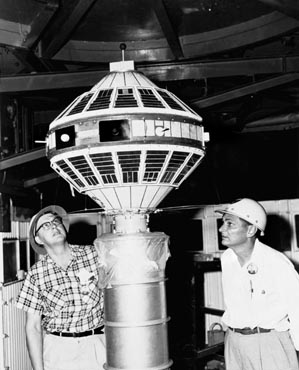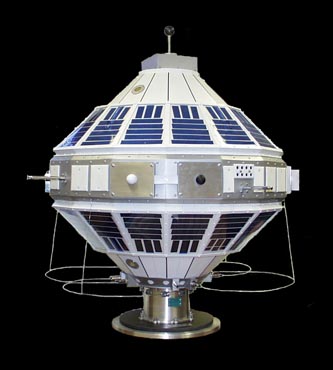Satellite anniversary marks 50 years of studying climate from space
On Oct. 13, 1959, UW–Madison professors Verner Suomi and Robert Parent crouched in a bunker at Cape Canaveral, sweating through the countdown for the Juno II rocket perched on its launching pad 150 yards away.

UW-Madison meteorologist Verner Suomi (left) looks at an early satellite instrument. Suomi and UW–Madison electrical engineer Robert Parent (not pictured) built one of the first instruments to allow scientists to study Earth’s weather and climate from space, a radiometer that launched on the Explorer 7 satellite on Oct. 13, 1959. Their radiometer kicked off an era of satellite-assisted climate studies that now influence everything from global climate models to the weather maps on the nightly news.
Photo: courtesy NASA
The Explorer 7 satellite atop the missile contained their newest scientific instrument, a radiometer designed to measure from space the amount of heat reaching and leaving the Earth.
Prior to satellite technology, meteorologists were limited to viewing the atmosphere from the ground up. Data about clouds in the middle and upper atmosphere and global measurements of heat absorption and emission were sketchy and localized at best, and scientists were quickly realizing that satellites offered the best opportunity to fill their knowledge gaps.
The launch went smoothly, and when Explorer 7 came to life in orbit, Suomi and Parent’s radiometer provided the first measurements of the Earth’s heat balance, the difference between the heat received from the sun and the heat exiting the atmosphere as a result of reflection and emission processes. Since uneven heating of the Earth’s surface is the primary driving force of the world’s weather, these measurements opened the door to a new era of satellite-based climate studies.
A 50th anniversary celebration of the launch of Explorer 7 will be held at the Monona Terrace Convention Center on Monday, Nov. 2. Several researchers who worked at UW–Madison with Suomi and Parent will be attending and participating in a panel discussion for the Oral History Project.

A full-scale model of the Explorer 7 satellite, which will be on display at a celebration of the 50th anniversary of its launch on Oct. 13, 1959.
Photo: courtesy UW–Madison Space Science and Engineering Center
As one of the first professors in UW–Madison’s new Department of Meteorology, Suomi had realized early on the importance of understanding the intricacies of the Earth’s climate. His 1953 dissertation, measuring the difference between the solar energy absorbed by a cornfield and that radiated back into the atmosphere, served as a springboard for ongoing studies of Earth-atmosphere energy balances.
He and Parent, a UW–Madison professor of electrical engineering, designed the radiometer on Explorer 7 to ramp up their studies to a global scale. Modest in size by today’s standards, Explorer 7 weighed less than 100 pounds and measured just two and a half feet on each side. Solar cells and 15 nickel-cadmium batteries powered instruments measuring solar proton radiation and cosmic rays.
Augmenting the satellite’s observations with ground-based measurements, Suomi and his team discovered that the Earth absorbs more solar energy than previously thought and demonstrated that it was possible to measure and quantify seasonal changes in the global heat budget.
Explorer 7 transmitted continuous data through February of 1961 and finally went silent in August of that year. Today, dozens of satellites from around the world continue its legacy of climate and weather studies.
“Climate studies, as inspired by the first look at the Earth from space by the radiation energy budget experiment on Explorer 7, have always been an important thrust at the center,” says Hank Revercomb, director of the Suomi-founded UW–Madison Space Science and Engineering Center (SSEC). “But now, with the realization that the rapid increase of carbon dioxide from fossil fuel burning can jeopardize the well-being of the whole planet, this research has taken on a new sense of urgency.”
After their success with Explorer 7, Suomi and Parent continued to drive new innovations in satellite climate monitoring, including a spin-scan cloud camera that pioneered continuous weather viewing from space and software that enabled “instant replays” of weather data.
In addition to the Explorer 7 50th anniversary celebration, a global community of scientists and researchers will meet Tuesday-Thursday, Nov. 3-5, at Monona Terrace for the sixth Geostationary Operational Environmental Satellite (GOES) Users’ Conference. This year’s conference, themed “Bringing Environmental Benefits to a Society of Users,” is presented by the National Oceanic and Atmospheric Administration (NOAA), with support from SSEC and the UW–Madison Cooperative Institute for Meteorological Satellite Studies (CIMSS).
More information about the conference can be found at http://cimss.ssec.wisc.edu/goes_r/meetings/guc2009/




